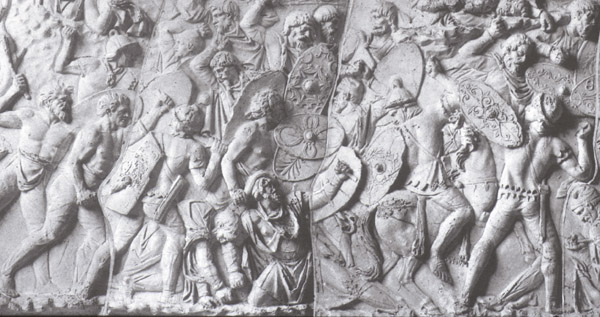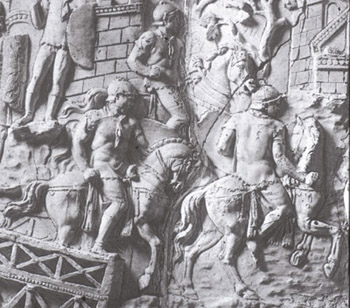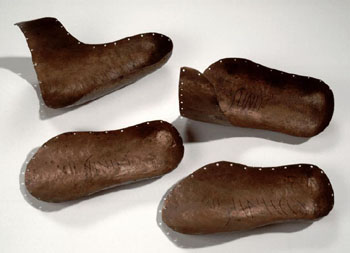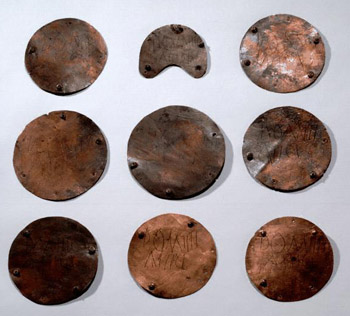Auxiliaries were non-citizen troops normally drawn from nations or regions
subject to Rome. They were expected to bear the brunt of the fighting,
and provided garrisons for the forts and frontiers, in support of the
legions which were usually held in reserve. These regiments were usually
raised in one part of the empire (or sometimes from beyond its boundaries)
and sent to another. Thereafter they tended to stay put, so in due course
their original ethnicity became diluted and ultimately lost. Auxiliaries’
rates of pay, and consequently their status, were lower than those of
the legionaries. However, on satisfactory completion of service they were
granted Roman citizenship and a gratuity. In addition to providing a personal
incentive, these awards to auxiliaries helped towards Romanising the provinces
in which they served.
Commanders of auxiliary regiments, like the executive officers of a legion, were generally Roman aristocrats on imperial service career-tracks.

This scene from Trajan's Column shows
Roman auxiliary infantry and cavalry (good examples of each appear on
the right) in combat with Dacian warriors.
© Author's collection
These regiments were smaller and more diverse than the legions. Some brought with them fighting skills from their homelands, such as Syrian archers or Balearic slingers. Most, however, were organised into infantry cohorts or cavalry wings. Some units combined both. The infantry were more lightly equipped than the legionaries, but otherwise weapons and tactics were similar. As in more recent times the cavalry was often regarded as an elite, and ornate accoutrements for men and horses have been found across the empire. It used to be thought that the lack of stirrups meant that Roman troops could not have operated as true cavalry, with the combined momentum of man and horse delivering a lethal blow of concentrated force, usually at the point of a lance. To achieve this horse and rider must be inextricably connected. Archaeological discoveries, however, have revealed that the Roman saddle was designed with projecting horns to keep the rider firmly in place, rather like the cowboy saddle of more recent times.


Roman auxiliary cavalry set out on patrol:
a detail from Trajan's Column. Their lack of stirrups, and the projecting
horns on their saddles, can clearly be seen.
© Author's collection
Bronze stiffeners from Newstead. Finds
from elsewhere have shown that these were used in the horns of Roman
cavalry saddles.
© SCRAN/National Museums of Scotland
Various types of auxiliary unit are known. The cohors quingenaria
peditata was an infantry unit commanded by a praefectus cohortis,
made up of six centuries of about 80 men each. Its nominal strength was
500. A cohors milliaria peditata contained ten centuries, and
was commanded by a tribunis. Similarly there were two kinds of
cavalry unit: an ala quingenaria, which contained 16 turmae
of 32 horsemen, giving it a nominal strength of 500, and an ala milliaria,
which had 24 turmae of 42 men, a nominal total of 1000. The latter
was a rare unit, commanded by a praefectus who ranked above the
other auxiliary commanders. Only one such unit, the Ala Petriana,
is known in Britain.
Composite units included the cohors quingenaria equitata, made up of 380 infantry and 120 cavalry, and the cohors milliaria equitata, which had 800 infantry and 240 cavalry.

Bronze backing-plates for a set of phalerae,
a set of nine decorative 'medals' worn on a chest-harness. The owner's
name, Dometius Atticus, is scratched on each piece: it is most clearly
seen at bottom centre.
© SCRAN/National Museums of Scotland
The fleet, which in Britain was known as the Classis Britannica,
was organised in much the same way as the auxiliary regiments, while irregular
units called numeri and cunei were sometimes deployed
in the frontier areas.